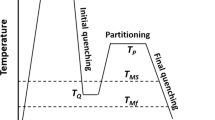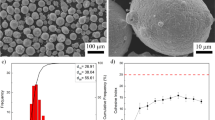The paper examines how cold isostatic pressing (CIP) of powder samples preformed by uniaxial pressing at up to 0.4 GPa influenced the density, coercive force, structure, hardness, and phase composition of the WC–8 wt.% Co (VK8) hardmetal after sintering in vacuum. A multiplication installation was employed for cold isostatic pressing. Transformer oil served as the pressure transmission medium. The density of the CIP samples increased linearly with pressure prior to sintering and reached its maximum at 0.2 GPa for the sintered CIP samples. The coercive force increased nonmonotonically with pressure. The WC grains refined when CIP pressure increased to 0.2 GPa but slightly coarsened after CIP at 0.3 and 0.4 GPa. The Co layer became thinner with pressure being increased to 0.3 GPa and slightly thicker at a pressure of 0.4 GPa. An intermetallic Co0.8W0.2 phase emerged in the samples subjected to preliminary CIP at 0.4 GPa. Hardness measurements at different loads up to 300 N showed that hardness increased at CIP pressures up to 0.3 GPa and slightly decreased in CIP at 0.4 GPa. Scanning electron microscopy photographs of the indenter imprints showed massive cracking of the WC grains. The results were analyzed using experimental data published previously on the effect of high isostatic pressure on the multiplication of dislocations and the fracture of single crystals. Those papers found that the deformation and fracture of single crystals under high isostatic pressures were accompanied by a sharp increase in the dislocation density. Each WC particle was compressed from all sides by the neighboring WC and Co particles, resulting in quasi-isostatic compression. However, the compressive forces are not equal in quasi-isostatic compression conditions, and there is always one force that is greater than the others. This force causes deformation or fracture leading to the mechanical activation of the powder because the imperfection of its particles increases and in turn influences the properties acquired by the hardmetal.










Similar content being viewed by others
References
A.S. Kurlov and A.I. Gusev, “Tungsten carbides: Structure, properties and application in hardmetals,” Springer Ser. Mater. Sci., 184, 6–34 (2013).
J. García, V.C. Ciprés, A. Blomqvist, and B. Kaplan, “Cemented carbide microstructures: a review,” Int. J. Refract. Met. Hard Mater., 80, 40–68 (2019).
G.Ya. Akimov, “Self-deformation during hydrostatic compression of powders consisting of ionic-covalent single-crystals of submicron size,” Phys. Solid State, 40, No. 2, 364–366 (1996).
V.P. Bondarenko, A.P. Khalepa, A.A. Baidenko, S.S. Dzhamarov, Yu.I. Chernyi, and G.P. Mikhailenko, “Effects of re-pressing under high hydrostatic pressure upon the shrinkage and density of sintered VK6 hard alloy blanks,” Powder Metall. Met. Ceram., 14, No. 5, 358–362 (1975).
G.Ya. Akimov, “Cold isostatic pressing as a method for fabricating ceramic products with high physicomechanical properties,” Refract. Ind. Ceram., 39, No. 7–8, 283–287 (1998).
S.Yu. Prilipko, V.M. Timchenko, G.Ya. Akimov, and V.I. Tkach, “Effect of cold isostatic pressing on the synthesis and particle size of lanthanum manganate,” Powder Metall. Met. Ceram., 47, No. 5–6, 284–287 (2008).
G.-D. Dutel, P. Langlois, D. Tingaud, D. Vrel, and G. Dirras, “Data on the influence of cold isostatic pre-compaction on mechanical properties of polycrystalline nickel sintered using Spark Plasma Sintering,” Data Brief, 11, 61–67 (2017).
T.T. Le, Z. Valdez-Nava, T. Lebey, and F. Mazaleyrat, “Influence of cold isostatic pressing on the magnetic properties of Ni–Zn–Cu ferrite,” AIP Adv., 8, No. 4, 047806 (2018).
A. Ekpy and S. Saritap, “Effects of powder hardness and particle size on the densification of cold isostatically pressed powders,” Turk. J. Eng. Environ. Sci., 26, No. 5, 377–384 (2002).
G.-H. Lee, S. Park, S. Kang, K.-H. Chung, and E.J. Lavernia, “Processing issues for cryomilled WC–Co nanopowders,” Mater. Trans., 44, No. 10, 1935–1941 (2003).
O.I. Fomina, S.N. Suvorova, and Ya.M. Turetskii, Encyclopedia of International Standards. Powder Metallurgy [in Russian], Moscow (1999), p. 312.
ISO 4499-4:2016, Hardmetals—Metallographic Determination of Microstructure. Part 4: Characterisation of Porosity, Carbon Defects and Eta-Phase Content, TC 119/SC 4 (2016).
ISO 4499-2:2020, Hardmetals—Metallographic Determination of Microstructure. Part 2: Measurement of WC Grain Size, TC 119/SC 4 (2020), p. 22.
JMicroVision Microanalysis Software. JMicroVision (1 file: 28.7 MB): https://jmicrovision.github.io/download.htm, last access: February 1, 2021.
G.Ya. Akimov, I.Yu. Prokhorov, and V.M. Timchenko, “Effect of quasi-hydrostatic compression on the mechanical properties of ceramics in the ZrO2 + 3 mol.% Y2O3 system,” Refract. Tech. Ceram., 43, No. 3, 100–102 (2002).
G.Ya. Akimov and I.Yu. Prokhorov, “Plastic stress relaxation during crack arrest in hydrostatically compressed alkali halide crystals,” Phys. Status Solidi A, 103, No. 1, 115–124 (1987).
T. Johannesson and B. Lehtinen, “On the plasticity of tungsten carbide,” Phys. Status Solidi A, 16, No. 2, 615–622 (1973).
J.D. Bolton and M. Redington, “Plastic deformation mechanisms in tungsten carbide,” J. Mater. Sci., 15, No. 12, 3150–3156 (1980).
K. Mannesson, “WC grain growth during sintering of cemented carbides,” Doctoral Thesis, Stockholm (2011), p. 42.
G.Ya. Akimov, T.A. Soloviova, P.I. Loboda, and S.Yu. Prilipko, “Mechanical activation of crystallization of amorphous boron and synthesis of Al3Ti under cold isostatic pressing of B–Al–(LaB6–TiB2) powder,” J. Superhard Mater., 39, No. 5, 343–348 (2017).
A. Love, S. Luyckx, and N. Sacks, “Quantitative relationships between magnetic properties, microstructure and composition of WC–Co alloys,” J. Alloys Compd., 489, No. 2, 465–468 (2010).
Author information
Authors and Affiliations
Corresponding author
Additional information
Translated from Poroshkova Metallurgiya, Vol. 60, Nos. 3–4 (538), pp. 18–27, 2021.
Rights and permissions
About this article
Cite this article
Akimov, G.Y., Andreev, I., Loboda, P. et al. The Effect of Cold Isostatic Pressing of Powder Billets Produced from the VK8 Hardmetal on its Hardness and Phase Composition After Sintering. Powder Metall Met Ceram 60, 142–149 (2021). https://doi.org/10.1007/s11106-021-00235-z
Received:
Published:
Issue Date:
DOI: https://doi.org/10.1007/s11106-021-00235-z




